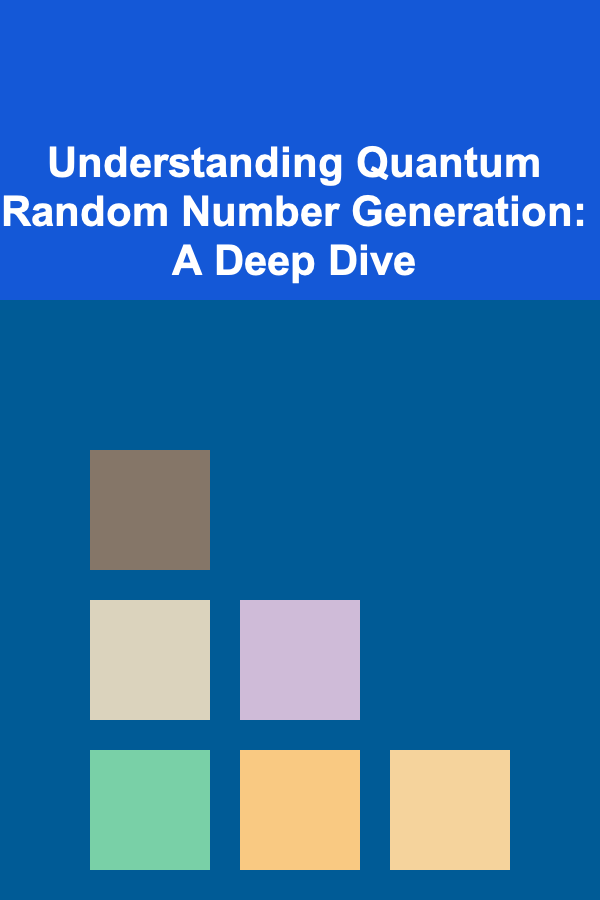
Understanding Quantum Random Number Generation: A Deep Dive
ebook include PDF & Audio bundle (Micro Guide)
$12.99$10.99
Limited Time Offer! Order within the next:

Random number generation is a fundamental necessity in modern computing. From cryptographic keys that secure our online transactions to simulations that model complex physical systems, randomness is a crucial ingredient. Traditional computers rely on algorithms that mimic randomness, known as pseudorandom number generators (PRNGs). While these algorithms are fast and efficient, they are inherently deterministic: given the same seed, they will always produce the same sequence of numbers. This predictability makes them vulnerable to attacks, especially in security-critical applications.
Quantum Random Number Generators (QRNGs) offer a fundamentally different approach. They harness the inherent randomness of quantum mechanics to generate truly unpredictable numbers. This article delves into the principles, technologies, and challenges associated with QRNGs, providing a comprehensive understanding of this exciting field.
The Quantum Foundation: Embracing Uncertainty
The cornerstone of QRNGs lies in the probabilistic nature of quantum mechanics. Unlike classical physics, where quantities are well-defined, quantum mechanics dictates that certain properties, such as the position or momentum of a particle, are described by probability distributions. This inherent uncertainty is not due to a lack of knowledge but rather a fundamental characteristic of the universe at the quantum level.
Several quantum phenomena can be exploited to generate random numbers. These include:
1. Quantum Superposition and Measurement
A qubit, the fundamental unit of quantum information, can exist in a superposition of states. Imagine a spin-1/2 particle, such as an electron. According to quantum mechanics, the spin can be either "up" or "down" along a chosen axis. However, until a measurement is made, the particle exists in a superposition of both states simultaneously. This superposition is described by a complex-valued vector in a two-dimensional Hilbert space. The state can be written as:
|ψ⟩ = α|0⟩ + β|1⟩
where |0⟩ represents the spin-up state, |1⟩ represents the spin-down state, and α and β are complex numbers such that |α|^2^ + |β|^2^ = 1. The values |α|^2^ and |β|^2^ represent the probabilities of measuring the spin as up or down, respectively.
When a measurement is performed on the qubit, it collapses into one of the basis states (either |0⟩ or |1⟩). If we prepare a qubit in an equal superposition, where |α|^2^ = |β|^2^ = 1/2, the measurement will yield a 0 or a 1 with equal probability. This process is fundamentally random and forms the basis for many QRNGs. The act of measurement itself is the source of the randomness. No matter how carefully we prepare the equal superposition, we cannot predict with certainty what the outcome of a single measurement will be.
2. Vacuum Fluctuations
Even in the emptiest region of space, devoid of matter, there exists a non-zero energy density due to quantum vacuum fluctuations. These fluctuations arise from the Heisenberg uncertainty principle, which dictates that the product of the uncertainties in position and momentum (or energy and time) must be greater than or equal to a constant. As a consequence, virtual particles spontaneously appear and disappear in the vacuum, leading to fluctuations in the electromagnetic field.
QRNGs based on vacuum fluctuations measure these tiny variations in the electric or magnetic field. The fluctuations are inherently random and can be amplified and digitized to produce a stream of random bits. These QRNGs often employ homodyne detection, where the weak signal of the vacuum fluctuations is mixed with a strong coherent light source (local oscillator). The interference between the two beams amplifies the signal, allowing it to be measured with conventional electronic components. However, careful calibration and noise reduction techniques are crucial to ensure that the generated numbers are truly random and not influenced by classical noise sources.
3. Photon Arrival Times
The emission of photons from a light source, such as a light-emitting diode (LED), is a quantum process. While the average rate of photon emission can be controlled by adjusting the current through the LED, the exact timing of individual photon arrivals is inherently random. This randomness arises from the spontaneous emission of photons, a process governed by quantum electrodynamics.
QRNGs based on photon arrival times detect individual photons using single-photon detectors. The time intervals between successive photon detections are then measured with high precision. These time intervals exhibit a statistical distribution that can be related to the randomness of the photon emission process. To ensure randomness, the light source is often attenuated to a level where photons are emitted sparsely, preventing classical effects like photon bunching from influencing the randomness.
4. Beam Splitters and Single Photons
A beam splitter is an optical device that divides a beam of light into two paths. When a single photon is incident on a beam splitter, it will either be reflected or transmitted. According to quantum mechanics, the photon has a certain probability of being reflected and a certain probability of being transmitted. For a perfectly balanced beam splitter (50/50), the photon has a 50% chance of being reflected and a 50% chance of being transmitted. Which path the photon takes is fundamentally random.
This randomness can be exploited to create a QRNG. A single-photon source emits photons one at a time. These photons are then directed onto a beam splitter. Detectors are placed at each output port of the beam splitter to detect whether the photon was reflected or transmitted. The outcome of each detection -- reflection or transmission -- provides a random bit.
QRNG Architectures: From Theory to Implementation
The theoretical principles of QRNGs are fascinating, but the real challenge lies in translating these principles into practical devices. Several QRNG architectures have been developed, each with its own strengths and weaknesses:
1. Measurement of Quantum Superposition
This approach, as mentioned earlier, leverages the superposition of quantum states and the randomness inherent in the measurement process. It typically involves preparing a qubit in an equal superposition and then measuring its state. The outcome of the measurement -- 0 or 1 -- provides a random bit.
Implementing this type of QRNG requires precise control over the qubit. This can be achieved using various physical systems, such as trapped ions, superconducting circuits, or nitrogen-vacancy (NV) centers in diamond. The qubit is manipulated using electromagnetic fields, and its state is read out using sensitive detectors. The quality of the randomness depends on the fidelity of the qubit preparation and measurement processes. Any imperfections in these processes can introduce bias and reduce the entropy of the generated random numbers.
2. Vacuum Fluctuation QRNGs
These QRNGs exploit the inherent randomness of quantum vacuum fluctuations. They typically involve a laser, a beam splitter, and two photodetectors. The vacuum fluctuations entering one port of the beam splitter interfere with a coherent light source entering the other port. The resulting intensity fluctuations are detected by the photodetectors. The difference in the signals from the two photodetectors is then digitized to generate random numbers.
One of the main challenges in implementing vacuum fluctuation QRNGs is the need to distinguish the weak signal of the vacuum fluctuations from classical noise sources, such as thermal noise and electronic noise. This requires careful shielding, low-noise amplifiers, and sophisticated signal processing techniques. Furthermore, the linearity and bandwidth of the detection system must be carefully characterized to ensure that the generated random numbers are not biased by non-linearities or bandwidth limitations.
3. Photonic QRNGs
Photonic QRNGs utilize various properties of photons to generate random numbers. As discussed, these can include measuring photon arrival times, using beam splitters with single photons, or measuring the polarization of single photons.
These QRNGs often rely on single-photon detectors, which are capable of detecting individual photons with high efficiency. However, single-photon detectors can be expensive and require cryogenic cooling in some cases. Another challenge is ensuring that the light source emits photons one at a time, preventing classical effects from influencing the randomness. This is typically achieved by attenuating the light source to a very low intensity.
4. Integrated QRNGs
With advancements in nanofabrication techniques, there is a growing trend towards integrating QRNGs onto small chips. These integrated QRNGs offer several advantages, including smaller size, lower power consumption, and potentially lower cost. They can be based on various quantum phenomena, such as quantum tunneling, quantum shot noise, or waveguide-based beam splitters.
Integrated QRNGs face challenges related to fabrication tolerances, optical losses, and the integration of single-photon detectors. However, the potential benefits of these devices are significant, making them a promising area of research and development.
Beyond Raw Bits: Post-Processing for Enhanced Randomness
The raw output from a QRNG may not be perfectly random. Imperfections in the experimental setup, classical noise sources, and manufacturing variations can introduce biases and correlations in the generated bits. Therefore, post-processing is an essential step in ensuring the quality of the random numbers. This process aims to extract the maximum possible entropy from the raw data and remove any remaining correlations.
Several post-processing techniques are commonly used:
1. Von Neumann Corrector
The Von Neumann corrector is a simple but effective algorithm for removing bias in a bit stream. It works by comparing adjacent bits in the stream. If the two bits are the same (00 or 11), they are discarded. If the two bits are different (01 or 10), the first bit is outputted. For example, if the input stream is 01101001, the output stream would be 000. This works because even if the probability of getting a 0 or 1 are not exactly 50/50, as long as the errors are independent, 01 and 10 will occur with equal probability.
While effective at removing bias, the Von Neumann corrector reduces the output rate by a factor of two or more. It is also not effective at removing correlations between bits.
2. Toeplitz Hashing
Toeplitz hashing is a more sophisticated technique that can remove both bias and correlations. It involves multiplying the raw bit stream by a Toeplitz matrix. A Toeplitz matrix is a matrix where each descending diagonal from left to right is constant. The elements of the Toeplitz matrix are typically chosen randomly. This operation effectively mixes the bits in the input stream, reducing correlations and improving the randomness.
Toeplitz hashing is more efficient than the Von Neumann corrector and can achieve higher output rates. However, it requires careful selection of the Toeplitz matrix to ensure that the output stream is truly random.
3. Advanced Entropy Extraction Algorithms
More advanced entropy extraction algorithms, such as those based on linear feedback shift registers (LFSRs) or cryptographic hash functions, can be used to further improve the randomness of the output stream. These algorithms are designed to extract the maximum possible entropy from the raw data while minimizing the impact on the output rate. These methods are more computationally intensive but provide a higher quality of randomness. The choice of algorithm depends on the specific application and the desired trade-off between randomness quality and output rate.
The selection of the appropriate post-processing technique depends on the characteristics of the raw data and the requirements of the application. It is crucial to carefully analyze the output of the QRNG and choose a post-processing technique that effectively removes any remaining biases or correlations.
Applications of Quantum Random Number Generators
The unique properties of QRNGs, especially their true randomness, make them invaluable for a wide range of applications:
1. Cryptography
Cryptography is arguably the most important application of QRNGs. Secure cryptographic keys are essential for protecting sensitive data, such as financial transactions, personal information, and government secrets. Traditional PRNGs are vulnerable to attacks because they are deterministic. An attacker who knows the seed of the PRNG can predict the entire sequence of random numbers, compromising the security of the cryptographic system.
QRNGs, on the other hand, provide truly unpredictable random numbers, making them ideal for generating cryptographic keys. These keys can be used in symmetric-key algorithms, such as AES, or asymmetric-key algorithms, such as RSA. The use of QRNGs in cryptography significantly enhances the security of these systems, making them more resistant to attacks. Furthermore, QRNGs are crucial for quantum key distribution (QKD), a technology that uses the laws of quantum mechanics to guarantee the security of key exchange.
2. Monte Carlo Simulations
Monte Carlo simulations are used in various fields, including physics, finance, and engineering, to model complex systems. These simulations rely on random numbers to sample from probability distributions and estimate the behavior of the system. The accuracy of the simulation depends on the quality of the random numbers used. Biased or correlated random numbers can lead to inaccurate results and misleading conclusions.
QRNGs can significantly improve the accuracy and reliability of Monte Carlo simulations by providing truly random numbers. This is particularly important for simulations of quantum systems, where the randomness of the underlying quantum mechanics must be accurately represented. For example, QRNGs can be used to simulate the behavior of electrons in materials, the dynamics of chemical reactions, or the evolution of financial markets.
3. Gaming and Gambling
In the gaming and gambling industry, randomness is essential for ensuring fairness and preventing cheating. Traditional PRNGs are often used in these applications, but their deterministic nature makes them vulnerable to manipulation. QRNGs offer a more secure and reliable source of randomness, ensuring that the games are fair and that the outcomes are truly unpredictable.
The use of QRNGs in gaming and gambling can increase trust and confidence among players. It can also prevent cheating and fraud, protecting the integrity of the games. For example, QRNGs can be used to shuffle cards in online poker games, generate random numbers for slot machines, or determine the outcome of lottery drawings.
4. Scientific Research
Many scientific experiments rely on random numbers for various purposes, such as selecting samples, assigning treatments, or generating noise. The quality of the random numbers can affect the validity and reproducibility of the results. QRNGs can provide a reliable and unbiased source of randomness, ensuring that the experiments are conducted fairly and that the results are accurate.
For example, QRNGs can be used in clinical trials to randomly assign patients to different treatment groups, preventing bias and ensuring that the results are statistically significant. They can also be used in materials science to generate random structures for simulating the properties of new materials. Furthermore, QRNGs can be used in cryptography research to develop and test new cryptographic algorithms.
5. Quantum Computing
While it might seem counterintuitive, QRNGs have a role to play in classical control and measurement in quantum computers. Generating truly random control pulses, for example, can be critical for certain quantum algorithms and for calibrating the quantum computer itself. They're also valuable for simulating the effects of noise and decoherence on quantum computations.
Challenges and Future Directions
Despite their many advantages, QRNGs face several challenges that need to be addressed to make them more widely accessible:
1. Cost
QRNGs are currently more expensive than traditional PRNGs. The cost of the hardware components, such as single-photon detectors and high-precision electronics, can be significant. However, as technology advances and production volumes increase, the cost of QRNGs is expected to decrease.
2. Size and Power Consumption
Many QRNG implementations are relatively bulky and consume a significant amount of power. This limits their use in portable devices and embedded systems. However, ongoing research efforts are focused on developing smaller, more energy-efficient QRNGs.
3. Certification and Validation
It can be challenging to certify and validate the randomness of QRNGs. Traditional statistical tests, such as the NIST Statistical Test Suite, can be used to assess the randomness of the output stream, but these tests are not foolproof. They can only detect certain types of biases and correlations. More sophisticated techniques, such as entropy estimation and information-theoretic analysis, are needed to provide a more rigorous assessment of the randomness.
4. Integration with Existing Systems
Integrating QRNGs with existing computing systems can be complex. QRNGs typically output raw bit streams that need to be post-processed and converted into a format that is compatible with the system. This requires specialized software and hardware interfaces.
Despite these challenges, the future of QRNGs is bright. Ongoing research efforts are focused on addressing these challenges and developing more practical and affordable QRNGs. Some promising directions include:
- Developing integrated QRNGs that can be manufactured at scale using standard semiconductor fabrication processes.
- Improving the efficiency and performance of single-photon detectors.
- Developing new post-processing techniques that can extract more entropy from the raw data.
- Creating standardized interfaces for integrating QRNGs with existing systems.
Conclusion
Quantum Random Number Generators represent a significant advancement in random number generation technology. By harnessing the inherent randomness of quantum mechanics, they provide a truly unpredictable source of randomness that is essential for a wide range of applications, including cryptography, Monte Carlo simulations, gaming, and scientific research. While challenges remain in terms of cost, size, power consumption, and certification, ongoing research efforts are paving the way for more practical and affordable QRNGs. As quantum technologies continue to mature, QRNGs are poised to play an increasingly important role in securing our digital world and enabling new scientific discoveries.
The adoption of QRNGs marks a shift towards embracing the fundamental unpredictability of the universe to solve critical problems in computing and security. Understanding the principles and technologies behind QRNGs is crucial for anyone involved in these fields, and will become even more so in the years to come.

How to Keep Kids Organized During Family Vacations
Read More
How to Make Money Online as a Technical Writer: 10 Actionable Ideas
Read More
How to Use Checklists to Keep Tasks Organized
Read More
How to Use Color to Create a Warm and Inviting Home Staging Look
Read More
How to Use Personal Safety Devices for Added Protection
Read More
How To Navigate Open-World Games Effectively
Read MoreOther Products

How to Keep Kids Organized During Family Vacations
Read More
How to Make Money Online as a Technical Writer: 10 Actionable Ideas
Read More
How to Use Checklists to Keep Tasks Organized
Read More
How to Use Color to Create a Warm and Inviting Home Staging Look
Read More
How to Use Personal Safety Devices for Added Protection
Read More